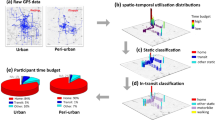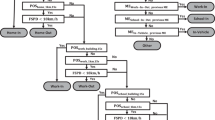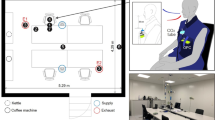Abstract
Human exposure to air pollution is associated with increased risk of morbidity and mortality. However, personal air pollution exposures can vary substantially depending on an individual’s daily activity patterns and air quality within their residence and workplace. This work developed and validated an adaptive buffer size (ABS) algorithm capable of dynamically classifying an individual’s time spent in predefined microenvironments using data from global positioning systems (GPS), motion sensors, temperature sensors, and light sensors. Twenty-two participants in Fort Collins, CO were recruited to carry a personal air sampler for a 48-h period. The personal sampler was retrofitted with a GPS and a pushbutton to complement the existing sensor measurements (temperature, motion, light). The pushbutton was used in conjunction with a traditional time-activity diary to note when the participant was located at “home”, “work”, or within an “other” microenvironment. The ABS algorithm predicted the amount of time spent in each microenvironment with a median accuracy of 99.1%, 98.9%, and 97.5% for the “home”, “work”, and “other” microenvironments. The ability to classify microenvironments dynamically in real time can enable the development of new sampling and measurement technologies that classify personal exposure by microenvironment.
This is a preview of subscription content, access via your institution
Access options
Subscribe to this journal
Receive 6 print issues and online access
$259.00 per year
only $43.17 per issue
Buy this article
- Purchase on Springer Link
- Instant access to full article PDF
Prices may be subject to local taxes which are calculated during checkout



Similar content being viewed by others
Change history
05 March 2020
The original version of this Article featured an incorrect supplementary figure file. This error has been rectified in the PDF and HTML versions of this Article.
References
Brook RD, Rajagopalan S, Pope CA, Brook JR, Bhatnagar A, Diez-Roux AV, et al. Particulate matter air pollution and cardiovascular disease: an update to the scientific statement from the American Heart Association. Circulation 2010;121:2331–78.
Cohen AJ, Brauer M, Burnett R, Anderson HR, Frostad J, Estep K, et al. Estimates and 25-year trends of the global burden of disease attributable to ambient air pollution: an analysis of data from the Global Burden of Diseases Study 2015. Lancet 2017;389:1907–18.
Mann JK, Balmes JR, Bruckner TA, Mortimer KM, Margolis HG, Pratt B, et al. Short-term effects of air pollution on wheeze in asthmatic children in Fresno, California. Environ Health Perspect. 2010;118:1497.
Peel JL, Tolbert PE, Klein M, Metzger KB, Flanders WD, Todd K, et al. Ambient air pollution and respiratory emergency department visits. Epidemiology 2005;16:164–74.
Pope CA III, Dockery DW. Health effects of fine particulate air pollution: lines that connect. J Air Waste Manag Assoc. 2006;56:709–42.
Branco P, Alvim-Ferraz M, Martins F, Sousa S. The microenvironmental modelling approach to assess children's exposure to air pollution–a review. Environ Res. 2014;135:317–32.
Lim S, Kim J, Kim T, Lee K, Yang W, Jun S, et al. Personal exposures to PM 2.5 and their relationships with microenvironmental concentrations. Atmos Environ. 2012;47:407–12.
Van Ryswyk K, Wheeler AJ, Wallace L, Kearney J, You H, Kulka R, et al. Impact of microenvironments and personal activities on personal PM 2.5 exposures among asthmatic children. J Exposure Sci Environ Epidemiol. 2014;24:260.
Baxter LK, Dionisio KL, Burke J, Sarnat SE, Sarnat JA, Hodas N, et al. Exposure prediction approaches used in air pollution epidemiology studies: key findings and future recommendations. J Expo Sci Environ Epidemiol. 2013;23:654–9.
Özkaynak H, Baxter LK, Dionisio KL, Burke J. Air pollution exposure prediction approaches used in air pollution epidemiology studies. J Expo Sci Environ Epidemiol 2013;23:566.
Adams C, Riggs P, Volckens J. Development of a method for personal, spatiotemporal exposure assessment. J Environ Monit. 2009;11:1331–9.
Breen MS, Long TC, Schultz BD, Crooks J, Breen M, Langstaff JE, et al. GPS-based microenvironment tracker (MicroTrac) model to estimate time–location of individuals for air pollution exposure assessments: Model evaluation in central North Carolina. J Exposure Sci Environ Epidemiol. 2014;24:412.
Elgethun K, Yost MG, Fitzpatrick CTE, Nyerges TL, Fenske RA. Comparison of global positioning system (GPS) tracking and parent-report diaries to characterize children’s time–location patterns. J Exposure Sci Environ Epidemiol. 2006;17:196.
Kim T, Lee K, Yang W, Yu SD. A new analytical method for the classification of time–location data obtained from the global positioning system (GPS). J Environ Monit. 2012;14:2270–4.
Steinle S, Reis S, Sabel CE. Quantifying human exposure to air pollution—moving from static monitoring to spatio-temporally resolved personal exposure assessment. Sci Total Environ. 2013;443:184–93.
Kelly P, Krenn P, Titze S, Stopher P, Foster C. Quantifying the difference between self-reported and global positioning systems-measured journey durations: a systematic review. Transp Rev. 2013;33:443–59.
Wu J, Jiang C, Houston D, Baker D, Delfino R. Automated time activity classification based on global positioning system (GPS) tracking data. Environ Health 2011;10:101.
Asimina S, Chapizanis D, Karakitsios S, Kontoroupis P, Asimakopoulos D, Maggos T, et al. Assessing and enhancing the utility of low-cost activity and location sensors for exposure studies. Environ Monit Assess. 2018;190:155.
Donaire-Gonzalez D, Valentín A, de Nazelle A, Ambros A, Carrasco-Turigas G, Seto E, et al. Benefits of mobile phone technology for personal environmental monitoring. JMIR mHealth and uHealth. 2016;4:356–64.
Glasgow ML, Rudra CB, Yoo E-H, Demirbas M, Merriman J, Nayak P, et al. Using smartphones to collect time–activity data for long-term personal-level air pollution exposure assessment. J Exposure Sci Environ Epidemiol. 2016;26:356.
Langlois C, Tiku S, Pasricha S. Indoor localization with smartphones. IEEE Consum Electron: Harnessing the sensor suite in your pocket. IEEE Consumer Electronics Magazine. 2017;6:70–80.
Nethery E, Mallach G, Rainham D, Goldberg MS, Wheeler AJ. Using Global Positioning Systems (GPS) and temperature data to generate time-activity classifications for estimating personal exposure in air monitoring studies: an automated method. Environ Health 2014;13:33.
Lee B, Lim C, Lee K. Classification of indoor-outdoor location using combined global positioning system (GPS) and temperature data for personal exposure assessment. Environ Health Prev Med. 2017;22:29.
Flynn JI, Coe DP, Larsen CA, Rider BC, Conger SA, Bassett JD. Detecting indoor and outdoor environments using the ActiGraph GT3X+ light sensor in children. Med Sci Sports Exerc. 2014;46:201–6.
Hu M, Li W, Li L, Houston D, Wu J. Refining time-activity classification of human subjects using the global positioning system. PloS ONE 2016;11:e0148875.
Tandon PS, Saelens BE, Zhou C, Kerr J, Christakis DA. Indoor versus outdoor time in preschoolers at child care. Am J Prev Med. 2013;44:85–8.
Pagels P, Raustorp A, Guban P, Fröberg A, Boldemann C. Compulsory school in-and outdoors—implications for school children’s physical activity and health during one academic year. Int J Environ Res Public Health 2016;13:699.
Kestens Y, Thierry B, Chaix B. Re-creating daily mobility histories for health research from raw GPS tracks: validation of a kernel-based algorithm using real-life data. Health Place. 2016;40:29–33.
Dewulf B, Neutens T, Van Dyck D, De Bourdeaudhuij I, Panis LI, Beckx C, et al. Dynamic assessment of inhaled air pollution using GPS and accelerometer data. J Transp Health. 2016;3:114–23.
Natonal Research Council. Research priorities for airborne particulate matter: IV. Continuing research progress: National Academies Press; 2004.
Bell ML, Dominici F, Ebisu K, Zeger SL. Samet JM. Spatial and temporal variation in PM2. 5 chemical composition in the United States for healtheffects studies. Environ Health Perspect. 2007;115:989–95.
Kelly FJ, Fussell J. Size, source and chemical composition as determinants of toxicity attributable to ambient particulate matter. Atmos Environ. 2012;60:504–26.
Valavanidis A, Fiotakis K, Vlachogianni T. Airborne particulate matter and human health: toxicological assessment and importance of size and composition of particles for oxidative damage and carcinogenic mechanisms. J Environ Sci Health C Environ Carcinog Ecotoxicol Rev. 2008;26:339–62.
Quinn C, Miller-Lionberg DD, Klunder KJ, Kwon J, Noth EM, Mehaffy J, et al. Personal exposure to PM2.5 black carbon and aerosol oxidative potential using an automated microenvironmental aerosol sampler (AMAS). Environ Sci Technol. 2018;52:11267–75.
Goudarzi MA, Landry RJ. Assessing horizontal positional accuracy of Google Earth imagery in the city of Montreal, Canada. Geod Cartogr. 2017;43:56–65.
Volckens J, Quinn C, Leith D, Mehaffy J, Henry CS, Miller‐Lionberg D. Development and evaluation of an ultrasonic personal aerosol sampler. Indoor Air 2017;27:409–16.
Sinnott RW. Virtues of the haversine. Sky Telesc. 1984;68:159.
Wu J, Jiang C, Liu Z, Houston D, Jaimes G, McConnell R. Performances of different global positioning system devices for time-location tracking in air pollution epidemiological studies. Environ Health Insights. 2010;4:S6246. https://doi.org/10.4137/EHI.S6246.
World Health Organization. WHO & International Commission on Non-Ionizing Radiation Protection. Global solar UV index: a practical guide. World Health Organization; 1995.
Pohlert T. The Pairwise Multiple Comparison of Mean Ranks Package (PMCMR). R package version 2014. http://CRAN.R-project.org/package=PMCMR.
HEI. Exposure factors handbook 2011 edition (final report). Washington D.C.: United States Environmental Protection Agency; 2011. Report no.: EPA/600/R-09/052F.
Wilson JG, Kingham S, Pearce J, Sturman AP. A review of intraurban variations in particulate air pollution: Implications for epidemiological research. Atmos Environ. 2005;39:6444–62.
Bekö G, Kjeldsen BU, Olsen Y, Schipperijn J, Wierzbicka A, Karottki DG, et al. Contribution of various microenvironments to the daily personal exposure to ultrafine particles: personal monitoring coupled with GPS tracking. Atmos Environ. 2015;110:122–9.
Koehler K, Good N, Wilson A, Mölter A, Moore BF, Carpenter T, et al. The Fort Collins commuter study: variability in personal exposure to air pollutants by microenvironment. Indoor Air 2019;29:231–41.
Langley RB. Dilution of precision. GPS World 1999;10:52–9.
Brunauer R, Hufnagl M, Rehrl K, Wagner A, editors. Motion pattern analysis enabling accurate travel mode detection from GPS data only. Proceedings of the 16th International IEEE Conference on Intelligent Transportation Systems (ITSC 2013). The Hague, Netherlands: IEEE; 2013.
Ellis K, Godbole S, Marshall S, Lanckriet G, Staudenmayer J, Kerr J. Identifying active travel behaviors in challenging environments using GPS, accelerometers, and machine learning algorithms. Front Public Health 2014;2:36.
Feng T, Timmermans HJ. Transportation mode recognition using GPS and accelerometer data. Transp Res Part C Emerg Technol. 2013;37:118–30.
Acknowledgements
This work was supported by grant ES24719 from the National Institute of Environmental Health Sciences and by grant OH010662 from the National Institute for Occupational Safety and Health. The authors wish to thank all of the participants who volunteered to help collect the samples. Finally, the authors would like to acknowledge those who helped with the development of the UPAS and AMAS: Daniel David Miller-Lionberg, Eric Wendt, Joshua Smith, Nathan Henry, and Nicholas Good.
Author information
Authors and Affiliations
Corresponding author
Ethics declarations
Conflict of interest
The authors declare that they have no conflict of interest.
Additional information
Publisher’s note Springer Nature remains neutral with regard to jurisdictional claims in published maps and institutional affiliations.
Supplementary information
Rights and permissions
About this article
Cite this article
Quinn, C., Anderson, G.B., Magzamen, S. et al. Dynamic classification of personal microenvironments using a suite of wearable, low-cost sensors. J Expo Sci Environ Epidemiol 30, 962–970 (2020). https://doi.org/10.1038/s41370-019-0198-2
Received:
Revised:
Accepted:
Published:
Issue Date:
DOI: https://doi.org/10.1038/s41370-019-0198-2
This article is cited by
-
Long-term exposure and health risk assessment from air pollution: impact of regional scale mobility
International Journal of Health Geographics (2023)
-
Microenvironment Tracker (MicroTrac) model to estimate time-location of individuals for air pollution exposure assessments: model evaluation using smartphone data
Journal of Exposure Science & Environmental Epidemiology (2023)
-
Public engagement with air quality data: using health behaviour change theory to support exposure-minimising behaviours
Journal of Exposure Science & Environmental Epidemiology (2023)
-
Automated classification of time-activity-location patterns for improved estimation of personal exposure to air pollution
Environmental Health (2022)



